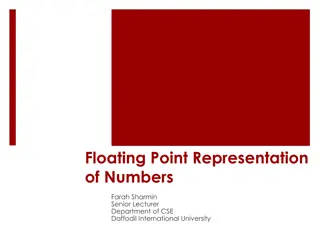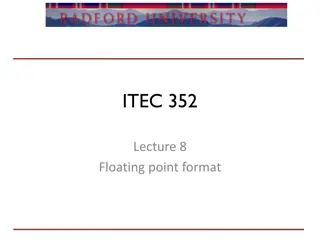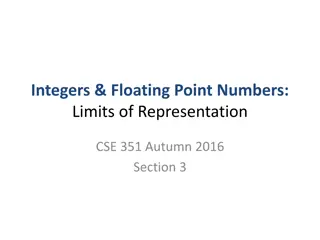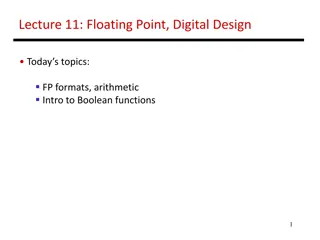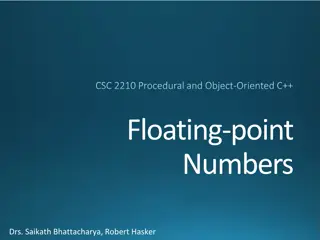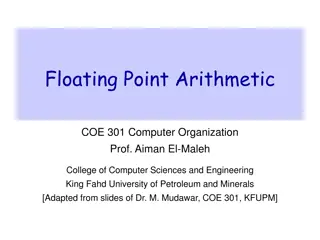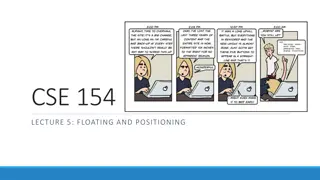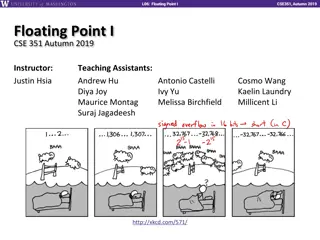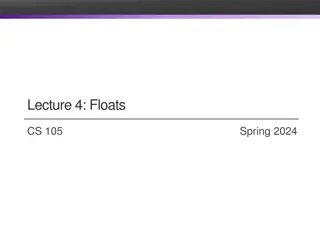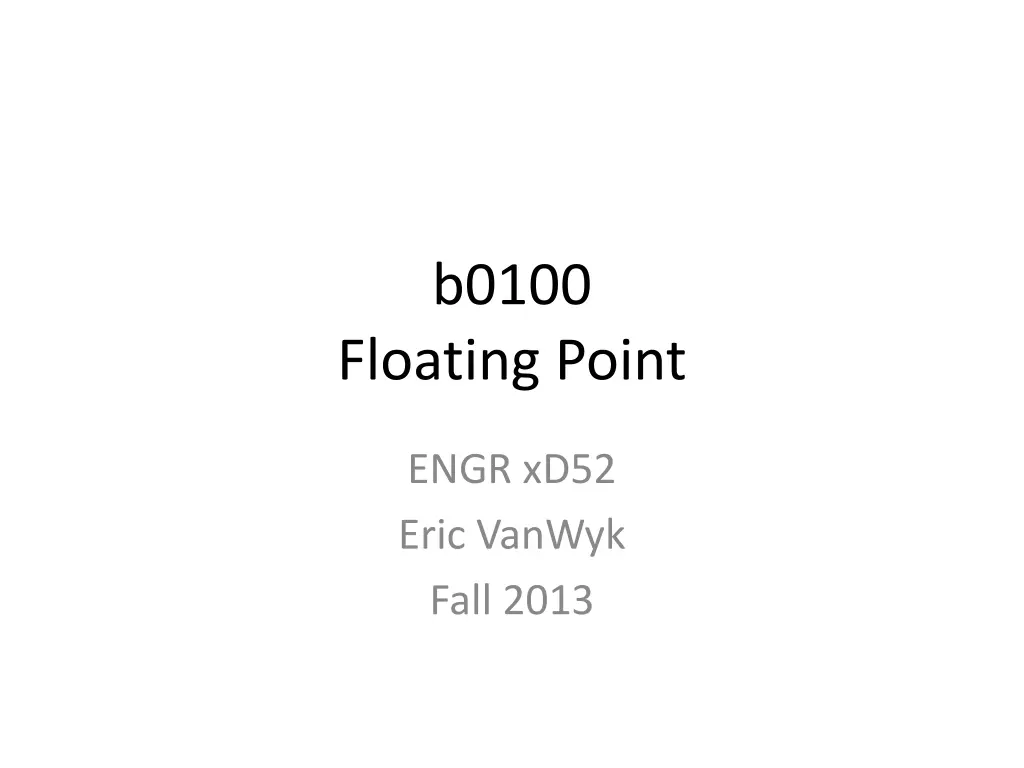
Better IQ Multiplication Techniques
Dive into the world of floating-point and fixed-point numbers with a focus on IQ multiplication techniques, examples, and comparisons. Explore algebraic similarities and learn from acknowledged sources to enhance your understanding of computer architecture concepts.
Download Presentation

Please find below an Image/Link to download the presentation.
The content on the website is provided AS IS for your information and personal use only. It may not be sold, licensed, or shared on other websites without obtaining consent from the author. If you encounter any issues during the download, it is possible that the publisher has removed the file from their server.
You are allowed to download the files provided on this website for personal or commercial use, subject to the condition that they are used lawfully. All files are the property of their respective owners.
The content on the website is provided AS IS for your information and personal use only. It may not be sold, licensed, or shared on other websites without obtaining consent from the author.
E N D
Presentation Transcript
b0100 Floating Point ENGR xD52 Eric VanWyk Fall 2013
Acknowledgements Mark L. Chang lecture notes for Computer Architecture (Olin ENGR3410) Patterson & Hennessy: Book & Lecture Notes Patterson s 1997 course notes (U.C. Berkeley CS 152, 1997) Tom Fountain 2000 course notes (Stanford EE182) Michael Wahl 2000 lecture notes (U. of Siegen CS 3339) Ben Dugan 2001 lecture notes (UW-CSE 378) Professor Scott Hauck lecture notes (UW EE 471) Mark L. Chang lecture notes for Digital Logic (NWU B01) http://docs.oracle.com/cd/E19957-01/806- 3568/ncg_goldberg.html
Today Better IQ representation example Review Multiplication in Fixed Point Signed/Unsigned and Multiplication Invent Floating Point Numbers Letters: Nicholas Eyre, Yun-Hsin Chen
Final Exam You are writing your own Final Exams Details are posted on the Wiki Today s board work should help you get in the mood. Main Point: Collaborative material review Anti Main Point: Angst
IQ Multiplication We ended last class with 3.0 *-0.5 in binary. 3 -0.5 -> -> 00110000 I4Q4 11111000 I4Q4 -1.5 -> 11101000 I4Q4 ?
Its just like Algebra, right? 11111000 -0.5 in I4Q4 * 00110000 3.0 in I4Q4 00000000 00000000 00000000 00000000 11111000 11111000 00000000 00000000 0010111010000000 ??? In I?Q?
Its just like Algebra, right? 1111.1000 -0.5 in I4Q4 * 0011.0000 3.0 in I4Q4 .00000000 0.0000000 00.000000 000.00000 1111.1000 11111.000 000000.00 0000000.0 00101110.10000000 46.5 In I8Q8
Its just like Algebra, right? 1111.1000 -0.5 in I4Q4 * 0011.0000 3.0 in I4Q4 .00000000 0.0000000 00.000000 000.00000 1111.1000 11111.000 000000.00 0000000.0 00101110.10000000 Incorrect? Correct! 46.5 In I8Q8
Its just like Algebra, right? 1111.1000 -0.5 in I4Q4 * 0011.0000 3.0 in I4Q4 0000000.00000000 0000000.00000000 0000000.00000000 0000000.00000000 1111111.10000000 I8Q8!! 1111111.00000000 0000000.00000000 0000000.00000000 11111110.10000000 -1.5 In I8Q8
Negative Second Operand? 01.11 I2Q2 d1.75 * 11.10 I2Q2 d0.50 .0000 0.111 01.11 011.1 0111. 0111 . 0111 . 0111 . 0111 . 01101111.0010 I4Q4 -d0.875
Negative Second Operand? 01.11 I2Q2 d1.75 * 11.10 I2Q2 d0.50 .0000 0.111 01.11 011.1 0111. From sign extension! 0111 . 0111 . 0111 . 0111 . No effect on output 01101111.0010 I4Q4 -d0.875
Observations The product is wider than the inputs InQx*ImQy=I(n+m)Q(x+y) Sign extend the inner terms and the multiplicand
Side Note The wikipedia article on binary multipliers is awful. Prove and rewrite the More advanced approach: signed integers section instead of any two homework assignments this semester.
Implications 3 categories of integer (or IQ) multiply instructions: MUL N*N->N, sign agnostic (only for Q=0) SMUL N*N->2N, signed UMUL N*N->2N, unsigned Multiplication uses ever increasing amounts of memory .?
Operations with outputs > inputs Addition uses 1 extra bit I4+I4 -> I5 [-8,7]+[-8,7] [-16,14] Multiplication needs twice as many bits (-1) I4*I4 -> I7 [-8,7]*[-8,7] [-64,56]
Finite Memory We can not expand every time. Usually, output format is input format. LSBs dropped are lost precision Always a little bad MSBs dropped are occasional catastrophes. Totally fine or absolutely terrible Overflow Errors
How to Handle? Overflow Catastrophic value change Saturate Wrong, but closer than Overflow Make the programmer deal with it They know their needs better than we do
Precision vs Max Magnitude Humans handle this with scientific notation. Lose precision to handle memory constraints Like choosing IQ format after each calculation(ish) 1.234*10^2 Significand * R^Exponent Significand in I?Q?, Exponent in I?
Lets Design Binary Scientific Notation Need to store: Sign Exponent Signficand Nice to be able to: Fit in memory conveniently Sort easily Accommodate bad things happening
Attempt 1 Store Significand in 2 s complement I1Q22 Store Exponent in 2 s complement I9 31 30 29 28 27 26 25 24 23 22 21 20 19 18 17 16 15 14 13 12 11 10 09 08 07 06 05 04 03 02 01 00 exponent Significand Most Positive: ?0.11 229 1 1 2255 5.8 1076 Smallest Positive: ?0.000 001 2 29 1 2 212 256 8.2 10 84
Attempt 1 Store Significand in 2 s complement I1Q22 Store Exponent in 2 s complement I9 31 30 29 28 27 26 25 24 23 22 21 20 19 18 17 16 15 14 13 12 11 10 09 08 07 06 05 04 03 02 01 00 exponent Significand Store Decimal -3.5 = 22 Exponent = d1 = b000000001 Significand = -d0.875 = b1.0011111 0.875
Attempt 1 Store Significand in 2 s complement I1Q22 Store Exponent in 2 s complement I9 31 30 29 28 27 26 25 24 23 22 21 20 19 18 17 16 15 14 13 12 11 10 09 08 07 06 05 04 03 02 01 00 0 0 0 0 0 0 0 1 0 1 0 0 1 1 1 1 1 1 1 1 1 1 1 1 1 1 1 1 1 1 1 1 Store Decimal -3.5 = 22 Exponent = d2 = b000000010 Significand = -d0.875 = b1.0011111 Hex: 0x004FFFFF 0.875
Attempt 1 Store Signficand in 2 s complement I1Q22 Store Exponent in 2 s complement I9 31 30 29 28 27 26 25 24 23 22 21 20 19 18 17 16 15 14 13 12 11 10 09 08 07 06 05 04 03 02 01 00 exponent Significand Does not sort well Bit #22 is the sign bit?! Many duplicated representations .5*2^0 = .25*2^1
Renormalization We use 0<= Significand < R 12.34*10^5 looks funny it is in U2Q2(R10) Scientific Notation is U1Q?R10. What is Engineering Notation? 123.456*10^6 TLDR: Pick a significand format, stick with it
Exponent Format Could use 2 s compliment. But that doesn t sort well Use biased notation instead. Signed value biased to be unsigned. Biased means add a fixed value Most negative number becomes 0. Makes sorting floats easy!
IEEE-754 Single Precision Float Floating Point (Float) = (-1)s * (1.fraction) * 2(exponent-127) 31 30 29 28 27 26 25 24 23 22 21 20 19 18 17 16 15 14 13 12 11 10 09 08 07 06 05 04 03 02 01 00 s exponent fraction 1 bit 8 bits 23 bits Alternative Name: binary32 Significand = 1.fraction
IEEE-754 Single Precision Float Floating Point (Float) = (-1)s * (1.significand) * 2(exponent-127) 31 30 29 28 27 26 25 24 23 22 21 20 19 18 17 16 15 14 13 12 11 10 09 08 07 06 05 04 03 02 01 00 s exponent significand Record Sign bit Convert Significand to U1Q23 Track changes to Exponent! Drop the MSB of Significand, record the rest Significand = leading one + Fraction Bias Exponent by +127, record
Multiplication in Floating Point Easy! Multiply Significands, Add Exponents 5*10^2 * 4*10^4 = (5*4)*10^(2+4) = 20*10^6 -> 2.0*10^7
Addition in Floating Point Almost Easy! Operands must have same exponent Normalize to most positive exponent 9.8*10^13 + 4*10^12 -> (9.8+0.4)*10^13 = 10.2*10^13 -> 1.02*10^14
IEEE-754 Single Precision Board Work Floating Point (Float) = (-1)s * (1.fraction) * 2(exponent-127) 31 30 29 28 27 26 25 24 23 22 21 20 19 18 17 16 15 14 13 12 11 10 09 08 07 06 05 04 03 02 01 00 s exponent fraction Convert to fp hex: 0.75 -10 .3 Convert from fp: 0x40410100 0xC0FFEE00 Find & prove flaws in my original float design Sorting, Packing efficiency, others?
Special Cases Exponent b00000000 Fraction = 0: Zero Fraction!=0: Subnormal Exponent b11111111 Fraction = 0: Infinity Fraction!= 0: Not a Number
When things go wrong Overflow it too big Underflow it too small Non-Associative Can t reorder operations Still commutative Order determines end precision! Humans like R10, but it is not representable
When things go wrong Catastrophic Cancellation Loss of precision from subtracting close numbers A-B = C when |A| >>> |C|, C will be imprecise Comparison Failures float f = 3.0/7.0; bool b = f == 3.0/7.0; http://docs.oracle.com/cd/E19957-01/806-3568/ncg_goldberg.html
Break my code! float mean(float nums[]) { float total = 0; for(int i=0;i<length(nums);i++) { total += nums[i]; } return total/length(nums); }
If you remember nothing else Precision: ~7 decimal digits Relative Error is constant, absolute error varies Exponent Range: 10^38 10^-38 Represent all integers up to 2^24 Sortable with integer operations
When you are debugging: Zero is 0x00000000 Infinity is h7F800000, -Infinity is hFF800000 NaN: h7FC00000 is most common I ve seen. Other NaNs exist, ish.
IEEE-754 Double Precision Float AKA Binary64 31 30 29 28 27 26 25 24 23 22 21 20 19 18 17 16 15 14 13 12 11 10 09 08 07 06 05 04 03 02 01 00 s exponent significand 31 30 29 28 27 26 25 24 23 22 21 20 19 18 17 16 15 14 13 12 11 10 09 08 07 06 05 04 03 02 01 00 significand (continued) 11 exponent bits, 52 explicit significand bits ~16 decimal digits, 10^308 10^-308 All Integers to 2^53
Clever Hacks or Total BS? Using integer operations on floats union intfloat { int i; float f; } x; Access like an integer with x.i; Access like a float with x.f; What does this do: x.i = x.i | 0x80000000; 31 30 29 28 27 26 25 24 23 22 21 20 19 18 17 16 15 14 13 12 11 10 09 08 07 06 05 04 03 02 01 00 s exponent significand
Story Time These clever hacks are terrible on x86 arch Separate floating point unit Forces conversion Doesn t take advantage of hardware These clever hacks are terrible in general Corner cases Legibility
Clever Hacks or Total BS? Float multiply by -1 Float divide by 8 using integer subtraction Rounded log base 2 of a float
Create your own Pain Create your own math problems that highlight the basic problems with floating point math. You can use decimal or binary Pick a format. 2 exponent digits, 7 significand?


